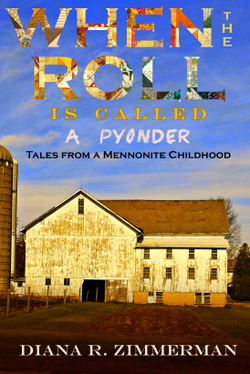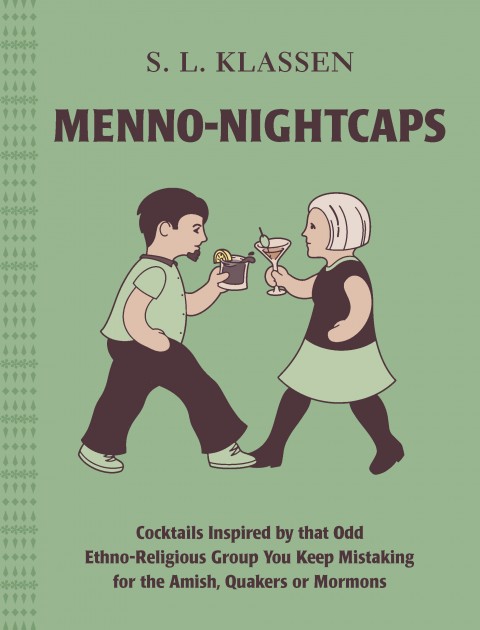 One of my earliest readers and twitter correspondents was Diana Zimmerman who wrote a memoir about her childhood in a rural Swiss Mennonite setting. I read it and wrote up some reflections on it, and made a cocktail in its honour. I posted this first in April of 2015.
One of my earliest readers and twitter correspondents was Diana Zimmerman who wrote a memoir about her childhood in a rural Swiss Mennonite setting. I read it and wrote up some reflections on it, and made a cocktail in its honour. I posted this first in April of 2015.Back in the good old days, life was simple. Kids roamed free on the farm and learned the cycles of life and death. And they lived in fear of corporal punishment. It’s awful hard to romanticize a Mennonite childhood in the 1970s when it comes with a green stick whose sole role is to beat you into submission.
This week, I read When the Roll is called a Pyonder: Tales from a Mennonite Childhood by Diana Zimmerman. The book is marketed for all ages and I was introduced to it by the author’s blog post which discussed the book being read by a grade three class. Normally there isn’t a whole lot of overlap between the books I choose to read in my spare time and those read aloud to eight-year olds. This was an exception. It is written from the perspective and even in the voice of a very young Mennonite girl on a farm in Pennsylvania. It’s a memoir of sorts, written as if a diary though ending at just the point when the narrator receives her own diary and begins to record her life. It is because of that young voice that the book is appropriate for children. The underlying themes and commentary on childhood, curiosity and the human desire to master one’s own life make the book a worthwhile read for adults.
Though episodic in nature, few of the narrator’s motivations and actions are completely removed from the fear of a beating. Time and again, she fails to approach her parents with questions or ask permission for fear of the potential spanking that would come of it. More than once, small animals suffered as a result. As, of course, did the narrator.
Because Mennonite theology places a strong emphasis on non-violence, it might come as a surprise that corporal punishment is practiced among us peace-loving people. It seems entirely hypocritical to swear nonviolence with one hand raised while using the other to swat your child into submission. But it wasn’t uncommon a short generation ago and it probably isn’t uncommon now. Quite recently, a community of Old Order Mennonites in Manitoba had all their children taken into care because of issues related to corporal punishment (to have their children returned, many have now promised, among other things, to cease using sticks and to only discipline their own children, not other members of the community). This community was unusual in many ways but corporal punishment itself, not so much. Non-violence has always had its limits.
No one ever really thought about applying our public pacifism to the private realm until the middle of the twentieth century and even then it hasn’t been done consistently. Children posed something of a problem to early Anabaptists who saw personal choice at the age of accountability as paramount and depended upon child rearing not to beat the Devil out of the kids but to prepare them for their own approach of adulthood upon which so much depended. And this steering was not to be taken lightly. Menno Simons himself weighed in on it, warning that parents should “spare not the rod if reason and necessity require it…a horse unbroken becomes headstrong; and a child left to himself will be willful” And Mennonites spent a couple centuries not sparing the rod, without a moment’s consideration of this as an act of violence. After the middle of the twentieth century this shifted within many branches of the Church but that was more thanks to the influence of twentieth-century psychology in child development than a thorough rethinking of peace theology. When I grew up in a more liberal Mennonite Church, spanking was growing rare and stories of switches, straps and green yard sticks that were taken down for the sake of “correcting” a child were becoming just stories. But plenty of branches of the Church think that resistance to change is one of their better qualities. And who is a better source of authority — Menno Simons with a whole stream of Old Testament passages to back him up or the secular Dr. Spock and Erik Erikson?
At any rate, strong memories of strong punishment demand a strong drink. To honour the corporal punishment in this particular book, today’s cocktail is called The Green Stick. The drink’s a version of a green tea gimlet with a few dashes of rhubarb bitters thrown in because, well, bitterness pretty much goes with the territory on this one.
The Green Stick
2 oz gin
1/2 oz lime syrup*
the juice of 1/2 lime
a dash or two of rhubarb bitters
ice
a single slice of lime1. Steep the green tea in the gin for at least an hour. Remove the tea and retain the gin.
2. Pour gin, lime syrup and lime juice into a cocktail shaker filled halfway with ice.
3. Shake vigorously.
4. Pour into a short glass with more ice. Add the bitters.
5. Garnish with lime slice
6. Drink while reflecting on all you have done wrong and need to change. The drink won’t help more than a spanking but it’ll taste better.
* juice of 1 lime, a tblsp of sugar and a bit of water heated until dissolved and then cooled to room temperature.


